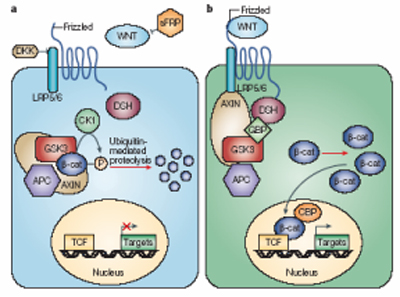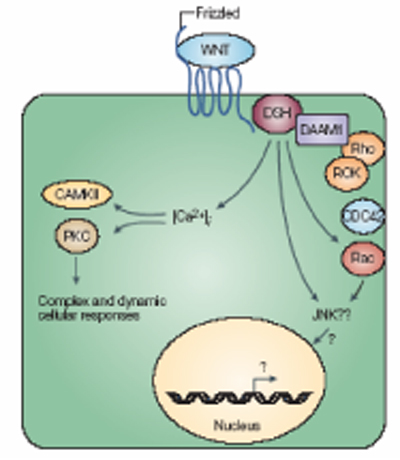Wnt
Wnt signaling is one of the key regulators of cell fate in physiological embryonic and adult tissue organization as well as in the development and maintenance of cancer. At the time of our first application, relatively little was known about how Wnt-dependent mechanisms in development might be mirrored by the respective deregulated variants in cancer. The evidence available at this focused almost exclusively on the tumor cells themselves and mainly referred to classical β-catenin-dependent Wnt signaling in malignant transformation and “cancer stemness”. However, once initiated, tumors progress and disseminate, which - apart from deregulated signaling within the tumor cell - requires interaction with the stromal compartment and extensive tissue remodeling. This strongly suggests a role of Wnt signaling beyond tumor initiation, occurring not only in the malignant cells but also between the different tissue components. Therefore, our research group focused on the comparative investigation of Wnt pathways with potential significance in the developmental as well as in the malignant context, thus aiming to achieve a better understanding of the mechanisms of tumor progression and, ultimately, ways and means to influence tumor progression.
Out of the multitude of Wnt-regulated mechanisms, the projects of the research group concentrate on three main areas:
First, we analyzed the effect of Wnt signals on cell adhesion, migration and tissue patterning during (post)embryonic development as well as in malignant tumors.
A second focus was on how Wnt signaling in the developmental and the malignant setting might be influenced by other signaling pathways, such as the Hedgehog cascade, the p53 analogue p63, the receptor tyrosine kinase PTK7 as well as lymphoma-associated factors.
Last, we investigated the role of Wnt signaling for the interaction of tumor cells and their benign neighbours within the tumor microenvironment.
There is growing evidence in the literature that the mechanisms we are focusing on are of key interest, especially regarding the transfer of knowledge from the developmental area to mechanisms active in transformed cells. The important role of alternative β-catenin-independent Wnt signaling, for instance, is increasingly recognized both in development and cancer. The planar cell polarity pathway (PCP), which was originally identified in the fly, where it determines orientation of wing hairs and body bristles, has now been recognized as a major regulator of cell movements ranging from developmental processes to epidermal wound repair. In the malignant setting, it has been shown that signaling via alternative Wnt ligands and receptors, such as ROR 1/2, is crucially involved in tumor progression and metastasis. Canonical signaling via β-catenin, on the other hand, seems to exert effects beyond its known functions in malignant intitiation, stemness and invasion and may also play a role in complex processes, such as chromosomal instability and chemoresistance. Additionally, it has been demonstrated that Wnt signaling is linked to other signaling networks which are important for physiological tissue development and maintainance as well as pathological deregulation in cancer. E. g., Wnt signaling is involved in chemokine signaling, regulating directional movement of benign and malignant cells. It is also connected with inflammatory signaling, in particular via toll-like receptors (TLR). Since TLR signals are crucial for lymphocytes, macrophages and other cells in the microenvironment, this underlines the fact that Wnt signals play an essential role in governing the interactions between different types of cells.
In conclusion, this demonstrates that the topic of our research group project falls into an area of high and very actual interest – it constitutes a scientific “hot spot”. Based on our own results from the first funding period, we therefore plan to continue the adopted course of comparative investigation of Wnt signaling in development and tumor progression with the long-term goal to eventually define therapeutic targets for antitumor strategies. Our concept to examine ONE pathway and its relevance for tumor pro-gession in DIFFERENT tumor entities (colorectal cancer, breast cancer, basal cell carcinoma, lymphoma) is also of paradigmatic importance for the field of translational oncology. It is now widely recognized that deregulated pathways need to be targeted across different tumor entities, since they rather depend on the individual patients’ “pathological” constitution than on the morphological tumor entity in general.

Fig. 1: Canonical Wnt-Signaling (a) in absence of a Wnt-signal, (b) after binding of a Wnt-ligand. APC = adenomatous poyposis coli, β-cat = β-Catenin, CBP = CREB- binding protein, CK1 = casein kinase 1, DKK = dickkopf, DSH = dishevelled, GSK3 = glycogen synthase kinase 3, LRP 5/6 = LDL receptor-related protein, TCF = T cell factor. from: Moon R.T. et al. 2005.

Fig. 2: Non-canonical Wnt/Ca2+- and "Planar Cell Polarity" signaling. CAMKII = calmodulin-dependent kinase II, CDC42 = cell division cycle, DSH = dishevelled, DAAM = dishevelled-associated activator of morphogenesis, JNK = Jun-N-terminal kinase, PKC = protein kinase C, Rac/ Rho = small GTP-binding proteins, ROK = Rho kinase. from Moon R.T. et al. 2005.

Fig. 3: Project- relevant Wnt pathways with the subprojects of Research Unit 942.

